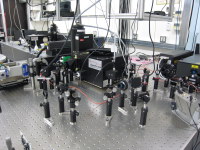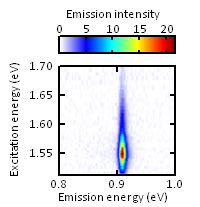Research:Photoluminescence of single-walled carbon nanotubes
Semiconducting carbon nanotubes have direct bandgaps which means that they have good optical emission properties. If electrons and holes are excited by light, they will recombine and emit light at the bandgap energy. This process is called photoluminescence.
Since all the atoms that compose single-walled nanotubes are at the surface, light emission is extremely sensitive to the surface condition. For example, if the nanotube is in contact with a substrate material, photoluminescence is quenched. In order to observe light emission, nanotubes can be suspended over trenches prepared on a substrate.


The actual setup in our lab consists of a Ti:sapphire laser for excitation, and an ojective lens that focuses the laser onto the sample, and a spectrometer.


Single-walled carbon nanotubes are fairly bright even at room temperature. The emission energy tells us about the bandgap energy. In addition, photoluminescence excitation spectroscopy can be used to identify the chirality of carbon nanotubes. When excitation energy is scanned, photoluminescence enhances when the excitation becomes resonant with peaks in the density of states. By measuring both the resonant energy and the emission energy, chirality of nanotubes can be determined.